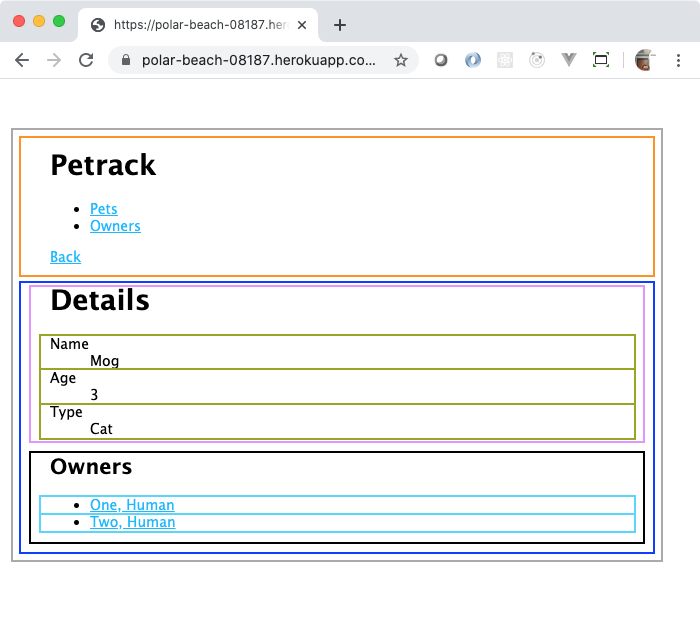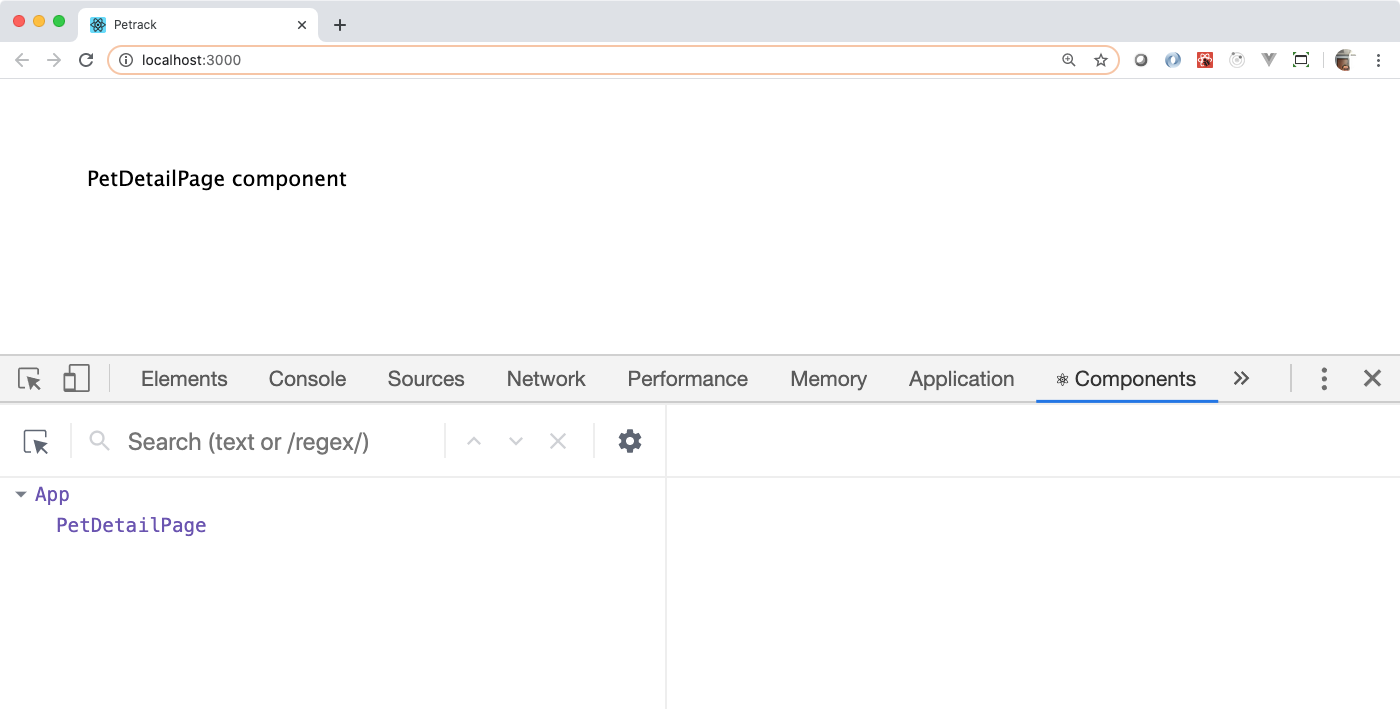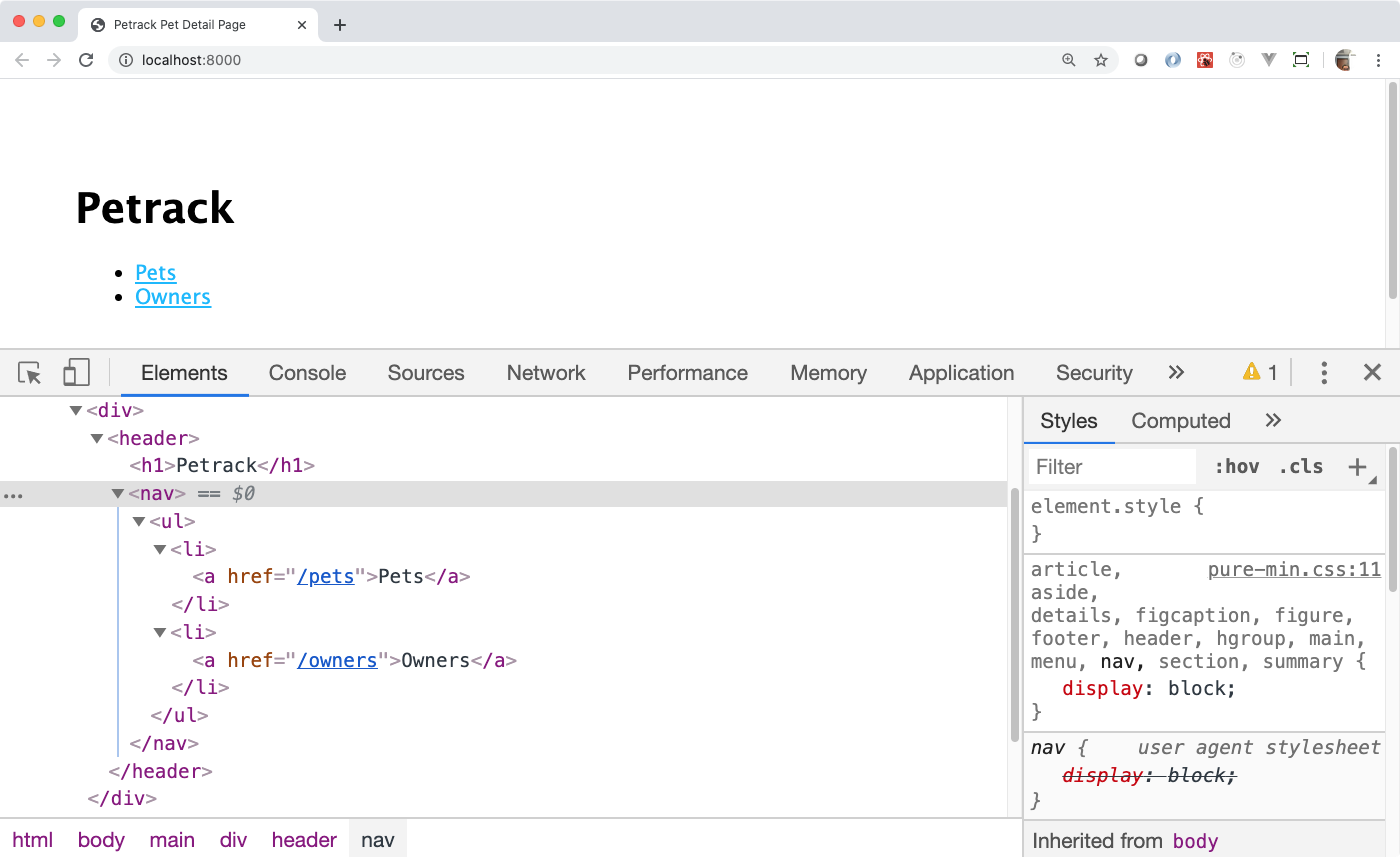
You will now work on creating the PetTrack page.
PetDetailPage: Created in this stepNavigation: Created in this stepPetDetailsPetDetailListPetInformationItemOwnersListOwnerLink
This guide will work top-down, in that it will start with the top-most (or outer-most) component, the PetDetailPage component. Then, it will move to a next level component, like Navigation. It will just keep adding components and getting them to work with the data from the AJAX call.
The PetDetailPage component will be responsible for showing the navigation component, the details list component, and the owners list component. None of those exist, yet, so just stub out a new component to hold the source.
Create a new file named PetDetailPage.js in the src directory. In that file, type this content into it.
import React from 'react';
const PetDetailPage = () =>
<div>PetDetailPage component</div> // Temporary so it builds
;
export default PetDetailPage;Here’s some analysis.
You will notice that the top of the file imports the React object, but you do not use it anywhere in the file! You have to do this because, remember, each JSX element, like <header>...</header>, ends up getting translated to React.createElement calls. Without the import statement, the React object would not exist and compiling would fail.
The const PetDetailPage = () => ... is just a normal arrow function.
The body of the component is a JSX expression <div></div> which Babel will translate into an invocation of React.createElement. Here’s what it looks like after passing through Babel.
var PetDetailPage = function PetDetailPage() {
return React.createElement("div", null, "PetDetailPage component");
} // Temporary so it builds
;This is just so you can import it into other components for use, which you will do now.
Open up src/App.js. Import the newly-created PetDetailPage component. Remember that this is Webpack that’s doing this for you, so you do not need to put the .js extension on the name of the module that you import.
Replace the <h1>Hello</h1> with <PetDetailPage></PetDetailPage>. Save all of your files. You should now see this content in your browser and Components tab.

The content of the src/App.js should look similar to this.
import React from 'react';
import PetDetailPage from './PetDetailPage';
function App() {
return (
<PetDetailPage></PetDetailPage>
);
}
export default App;Since PetDetailPage has no child content, you could also write that code like this, with the ending slash.
import React from 'react';
import PetDetailPage from './PetDetailPage';
function App() {
return (
<PetDetailPage />
);
}
export default App;Create a new file named Navigation.js in the src directory of your application. Put this content in there. Please type it rather than copy and paste it.
import React from 'react';
const Navigation = () =>
<header>
<h1>Petrack</h1>
<nav>
<ul>
<li>
<a href="/pets">Pets</a>
</li>
<li>
<a href="/owners">Owners</a>
</li>
</ul>
</nav>
</header>
;
export default Navigation;All of the JSX, the html-looking tags, those get converted into the calls to React.createElement. When Babel gets done with it, it looks like this, which is just an ugly version of one call to React.createElement for each of the elements in the JSX.
var Navigation = function Navigation() {
return React.createElement("header", null, React.createElement("h1", null, "Petrack"), React.createElement("nav", null, React.createElement("ul", null, React.createElement("li", null, React.createElement("a", {
href: "/pets"
}, "Pets")), React.createElement("li", null, React.createElement("a", {
href: "/owners"
}, "Owners")))));
};Back in the src/PetDetailPage.js file, import the Navigation component and replace the <div>PetDetailPage component</div> with the Navigation component much like you did in the App component with PetDetailPage.
Once you save your files, you should see the navigation.

You created two new components and added them to the src directory. You imported them so that other components could use them. It was fast and easy and (hopefully) painless. JSX is lovely to work with, far easier than the calls to React.createElement if that didn’t exist.
You will now work on creating the PetTrack page.
PetDetailPage: Created in this stepNavigation: Created in this stepPetDetailsPetDetailListPetInformationItemOwnersListOwnerLink
This guide will work top-down, in that it will start with the top-most (or outer-most) component, the PetDetailPage component. Then, it will move to a next level component, like Navigation. It will just keep adding components and getting them to work with the data from the AJAX call.
The PetDetailPage component will be responsible for showing the navigation component, the details list component, and the owners list component. None of those exist, yet, so just stub out a new component to hold the source.
Create a new file named PetDetailPage.js in the src directory. In that file, type this content into it.
import React from 'react';
const PetDetailPage = () =>
<div>PetDetailPage component</div> // Temporary so it builds
;
export default PetDetailPage;Here’s some analysis.
You will notice that the top of the file imports the React object, but you do not use it anywhere in the file! You have to do this because, remember, each JSX element, like <header>...</header>, ends up getting translated to React.createElement calls. Without the import statement, the React object would not exist and compiling would fail.
The const PetDetailPage = () => ... is just a normal arrow function.
The body of the component is a JSX expression <div></div> which Babel will translate into an invocation of React.createElement. Here’s what it looks like after passing through Babel.
var PetDetailPage = function PetDetailPage() {
return React.createElement("div", null, "PetDetailPage component");
} // Temporary so it builds
;This is just so you can import it into other components for use, which you will do now.
Open up src/App.js. Import the newly-created PetDetailPage component. Remember that this is Webpack that’s doing this for you, so you do not need to put the .js extension on the name of the module that you import.
Replace the <h1>Hello</h1> with <PetDetailPage></PetDetailPage>. Save all of your files. You should now see this content in your browser and Components tab.

The content of the src/App.js should look similar to this.
import React from 'react';
import PetDetailPage from './PetDetailPage';
function App() {
return (
<PetDetailPage></PetDetailPage>
);
}
export default App;Since PetDetailPage has no child content, you could also write that code like this, with the ending slash.
import React from 'react';
import PetDetailPage from './PetDetailPage';
function App() {
return (
<PetDetailPage />
);
}
export default App;Create a new file named Navigation.js in the src directory of your application. Put this content in there. Please type it rather than copy and paste it.
import React from 'react';
const Navigation = () =>
<header>
<h1>Petrack</h1>
<nav>
<ul>
<li>
<a href="/pets">Pets</a>
</li>
<li>
<a href="/owners">Owners</a>
</li>
</ul>
</nav>
</header>
;
export default Navigation;All of the JSX, the html-looking tags, those get converted into the calls to React.createElement. When Babel gets done with it, it looks like this, which is just an ugly version of one call to React.createElement for each of the elements in the JSX.
var Navigation = function Navigation() {
return React.createElement("header", null, React.createElement("h1", null, "Petrack"), React.createElement("nav", null, React.createElement("ul", null, React.createElement("li", null, React.createElement("a", {
href: "/pets"
}, "Pets")), React.createElement("li", null, React.createElement("a", {
href: "/owners"
}, "Owners")))));
};Back in the src/PetDetailPage.js file, import the Navigation component and replace the <div>PetDetailPage component</div> with the Navigation component much like you did in the App component with PetDetailPage.
Once you save your files, you should see the navigation.

You created two new components and added them to the src directory. You imported them so that other components could use them. It was fast and easy and (hopefully) painless. JSX is lovely to work with, far easier than the calls to React.createElement if that didn’t exist.